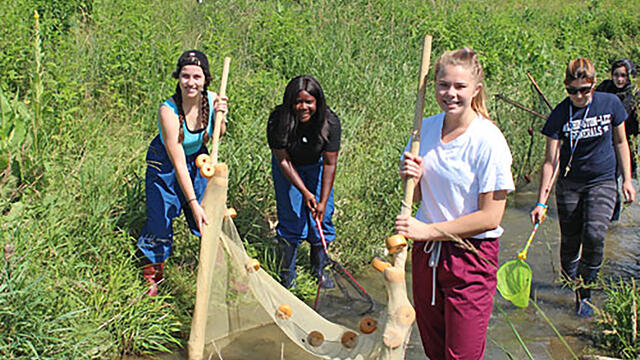Neither snow nor freezing temps stops Biology students’ pursuit of research
Less than two weeks after a late March nor’easter dumped more than a foot of snow on campus, McDaniel juniors Taylor Bauman and Garrett Gregoire went fishing in the nearby Haines Branch Creek near the Lehigh Cement Company quarry in Union Bridge, Md.

Less than two weeks after a late March nor’easter dumped more than a foot of snow on campus, McDaniel juniors Taylor Bauman and Garrett Gregoire went fishing in the nearby Haines Branch Creek near the Lehigh Cement Company quarry in Union Bridge, Md.
Less than two weeks after a late March nor’easter dumped more than a foot of snow on campus, McDaniel juniors Taylor Bauman and Garrett Gregoire went fishing in the nearby Haines Branch Creek near the Lehigh Cement Company quarry in Union Bridge, Md.
Dressed in boots, snow parkas and gloves, the Biology majors scoured the creek in search of the elusive black-nosed dace — a species of minnow — that they needed for their research study to ultimately assess the ecological health of the stream. Bauman of Charlottesville, Va., and Gregoire of Taylorsville, N.C., had designed and built a complex system back in the lab to determine the health of the 2.5-inch-long fish by measuring how long the fish could swim until exhausted. The fish were returned to their habitat unharmed once the study was completed.
Bauman and Gregoire are among McDaniel students in three Biology classes conducting authentic scientific research as part of the Quarry Life project, a study to assess the effectiveness of the cement company’s stream restoration. When all the data has been analyzed and compiled in a report, the McDaniel classes will have created a portable template for partnerships between educational institutions and cement companies to assess the effectiveness of habitat restoration by evaluating the functional health of the ecosystem.
The McDaniel collaboration will be entered into a contest being conducted by Lehigh Cement Company’s parent company, HeidelbergCement, for its Quarry Life Award 2018. But what is most important to the students is that their research projects are contributing to a bigger picture — a protocol to determine the functional health of an entire ecosystem and the effectiveness of stream restoration efforts.

Garrett Gregoire and Taylor Bauman analyze data from their research on the health of Haines Branch Creek.
“Experiential learning is a central theme here at the college and the Quarry Life project is augmenting a major theme of ours — to provide students with the opportunity to practice the skills of, and actually become, research scientists,” says Biology professor Katie Staab, whose Animal Physiology class focused on learning techniques they can use to evaluate the health of aquatic animals, such as the black-nosed dace, living in the stream.
The two other classes, Conservation Biology and Ecology under the mentorship of professors Jason Scullion and Holly Martinson, concentrated their research on the habitat surrounding the stream. The Conservation Biology students deployed 22 camera “traps” along the regions bordering the stream to study the wildlife by assessing the behavior of certain mammals and the abundance and diversity of the wildlife living in the Haines Branch valley.
Martinson’s Ecology class examined terrestrial plant communities looking at the health of the native trees and herbaceous plants Lehigh strategically planted along the stream. The students are determining the health of the trees, diversity of the plants and abundance and activity of invertebrate animals such as crayfish, ground beetles and bees.
While the research was conducted during the spring semester, some of the students are on campus this summer doing unrelated research, and they will guide high school students from the Summer Science Academy at McDaniel in a bio-blitz of the Haines Branch creek. During this community-based outing, the group will assess fish and pollinator species diversity at multiple locations along and around the stream.
The students involved in the semester-long research relished the process as much as the contribution they are making.
“The best part for me was that we were doing real research,” says Bauman, explaining that the level of dissolved oxygen in the water, an indicator of stream health, also is a determinant of the health of the fish that live in it. “We had to do our own troubleshooting and problem solving to come up with our little fish swimming pool to demonstrate how long our dace could swim before becoming exhausted — which reflected how healthy they are.”
Each of the students were quick to point out that their research would forever be a starting point, a contribution that others would build on.
“What’s most rewarding to me is that our research is the start of something bigger,” says Ashly Nsangou, a rising senior Biochemistry major originally from Cameroon and currently of New Carrollton, Md., who studied oak trees on the banks of the streams. “People can use our research to figure out ecosystem health and how to improve it.”
Making a scientific contribution was the best part of the work for Gregoire as well.
“It feels really good to know that we established a foundation for others to build on,” says Gregoire. “Now catching the fish in the freezing cold? That’s another issue!”
McDaniel students (l–r) Monica McInerney, Ashly Nsangou and Taylor Bauman, with Summer Science Academy high school students Laura Jayne and Abeeha Raza in background, check on the abundance and health of fish and other wildlife in the Haines Branch Creek near the Lehigh Cement Company quarry in Union Bridge, Md.